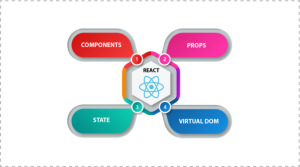 In the rapidly evolving world of mobile app development, efficiency and cross-platform compatibility have become paramount. React Native, a powerful framework created by Facebook, has risen to prominence as an exceptional solution for building mobile apps that work seamlessly on both iOS and Android. In this comprehensive guide, we’ll dive deep into the realm of React Native, exploring its core concepts, advantages, real-world applications, and how to get started on your journey.
In the rapidly evolving world of mobile app development, efficiency and cross-platform compatibility have become paramount. React Native, a powerful framework created by Facebook, has risen to prominence as an exceptional solution for building mobile apps that work seamlessly on both iOS and Android. In this comprehensive guide, we’ll dive deep into the realm of React Native, exploring its core concepts, advantages, real-world applications, and how to get started on your journey.
Understanding React Native
React Native is an open-source framework that allows developers to build mobile applications using JavaScript and React, a popular JavaScript library for building user interfaces. What sets React Native apart is its ability to create truly native mobile apps by using the same codebase for both iOS and Android platforms.
 Key Features of React Native
Key Features of React Native
- Cross-Platform Compatibility: The hallmark feature of React Native is its ability to write code once and run it on multiple platforms. This significantly reduces development time and effort compared to building separate apps for iOS and Android.
- Native Performance: React Native apps deliver native-like performance, as they are compiled to native code. This ensures a smooth and responsive user experience.
- Reusable Components: React Native allows developers to create reusable UI components, streamlining the development process and ensuring consistency across the app.
- Hot Reloading: Developers can instantly see the effects of code changes without rebuilding the entire app. This feature accelerates development and debugging.
- Large Community and Ecosystem: React Native has a vibrant community of developers, along with a rich ecosystem of libraries and third-party plugins that extend its functionality.
 Advantages of React Native
Advantages of React Native
- Cost-Efficient Development: With a single codebase for multiple platforms, React Native reduces development costs and accelerates time-to-market.
- Fast Iteration: Hot reloading allows developers to make changes and see the results in real-time, speeding up the development cycle.
- Native-Like Performance: React Native apps are known for their high performance, thanks to their ability to compile to native code.
- Reusable Components: Developers can create and reuse UI components, maintaining consistency and reducing redundant work.
- Third-Party Libraries: The React Native ecosystem offers a plethora of third-party libraries and plugins, saving development time.
Real-World Applications
React Native has found applications in various industries and domains, making it a versatile choice for a wide range of projects:
- E-Commerce: Many e-commerce giants, including Alibaba and Walmart, use React Native for their mobile apps, offering a seamless shopping experience to users on both iOS and Android.
- Social Media: Popular social media apps like Instagram and Facebook use React Native to ensure a consistent experience across platforms.
- Finance: Finance and banking apps, such as Coinbase and Robinhood, leverage React Native’s efficiency and performance to provide users with real-time data and trading capabilities.
- Healthcare: Health and fitness apps like Airbnb’s Airbnb.com use React Native for their user-friendly interfaces, enabling users to book accommodations effortlessly.
- Travel: Apps like Uber and Airbnb utilize React Native to provide a unified experience to users, regardless of their mobile device.
Getting Started with React Native
If you’re eager to dive into React Native development, here’s a roadmap to help you get started:
- Set Up Your Development Environment: Install Node.js, npm (Node Package Manager), and a code editor like Visual Studio Code.
- Install React Native CLI: Use npm to install the React Native Command Line Interface (CLI) globally on your system.
- Create Your First React Native App: Use the
react-native initcommand to create a new React Native project. You can choose the programming language you prefer (JavaScript or TypeScript). - Explore React Native Components: Familiarize yourself with React Native’s core components and libraries. React Native provides components for UI elements like buttons, text input, and lists.
- Practice and Build Projects: Start with small projects to practice your skills. Gradually, work on more complex apps to deepen your understanding.
- Leverage Online Resources: Utilize React Native documentation, tutorials, and online communities to seek guidance and collaborate with other developers.
Conclusion
React Native has emerged as a game-changing framework in the world of mobile app development. Its ability to create cross-platform apps with native-like performance, along with its cost-efficiency and strong developer community, has made it a top choice for businesses and developers worldwide. Whether you’re a seasoned developer looking to expand your skill set or a newcomer eager to enter the mobile app development landscape, React Native offers a versatile and powerful platform to bring your ideas to life. So, embark on your React Native journey with confidence and explore the endless possibilities of mobile app development.

